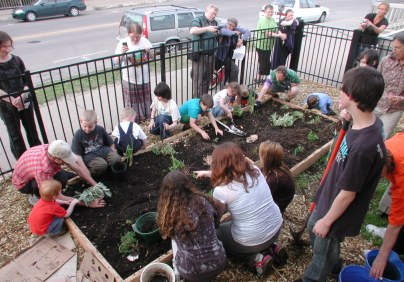
By Gigi Wood
He’s always been a tree hugger.
Fred Meyer, founder of Backyard Abundance, was looking to make more of an impact on the environment when he started the Iowa City-based nonprofit in 2006.
“I’ve always been a tree hugger, I’ve always loved being outside, I’ve always loved the environment,” said Mr. Meyer, who is a certified permaculture designer, permaculture teacher, master gardener and master conservationist. “I always planted trees and cleaned up roadways, but doing these things I was just watching the environment crumble around me.”
At the same time, he was trying to find ways to use less water in his garden. That’s where his research began. After awhile, he decided he wanted to share with others what he had learned. The result is the company Backyard Abundance.
Mr. Meyer started it by providing yard tours of homes with sustainable garden designs. The company still gives tours, but now it also helps clients improve the environmental health of local landscapes through presentations, workshops and classes and one-on-one design consultation.
One of its first major projects was theDiscoveryGardenon the northside of theIowa Cityrecreation center, at220 S. Gilbert St. Backyard Abundance also recently completed an overhaul of the Eye Donor Memorial Garden at the main entrance of the University of Iowa Hospitals and Clinics.
Whether it’s a home landscape, commercial or municipal project, all of Backyard Abundance’s jobs share a common thread: they meet the individual values of the client. Those values aren’t as simple as “saving the planet” or “being a better global citizen.” Instead, project goals revolve around the specific interest of the client, whether it be reducing the amount of water waste on a property or attracting wildlife to a patch of land.
“One of the reasons why I started Backyard Abundance, people wanted to help the environment but didn’t know how,” Mr. Meyer said. “And even if they did know how, a lot of the approaches we take toward saving the environment take a lot of time and a lot of investment and they interfere with our life.”
The company helps eliminate those obstacles.
“Focusing on the environment usually means picking up roadways and planting trees and then you have to maintain it and it costs a lot of money,” he said. “Instead, I want to take a different approach and show people how they can help the environment with very little effort. In fact, make it so that it weaves in with what they’re already doing.”
For example, eating locally grown food might be important to a client, but that client may not have time to grow and maintain a vegetable garden. Instead, Mr. Meyer would suggest planting a perennial, edible landscape with plants that grow berries and other foods and come back year after with little to no tending.
Backyard Abundance often creates landscapes with companion plantings. At theDiscoveryGarden, cherry trees are planted next to comfrey shrubs, strawberry plants and yarrow. The comfrey leaves fertilize the tree, strawberries suppress weeds and prevent water evaporation, while the yarrow keeps away pests.
“It mimics what healthy ecosystems do,” Mr. Meyer said.
For those who value water, rain gardens tend to be involved with the project.
“It becomes a reflection of what they value,” he said. “Every time they see that rain garden fill up with water, it’s this wonderful thing for the environment and makes them feel great, and how often do people feel great about helping the environment? Once they start feeling good about it, then they’ll want to start doing more.”
People don’t always feel great about helping the environment because it can be very frustrating when a project doesn’t work out or is abandoned because it requires too much effort. Backyard Abundance projects keep things simple so clients feel good about the work and will want to take on more.
“Doing something to help the environment, usually you feel guilty because we’re not helping the environment,” Mr. Meyer said. “We feel bad because we’re trashing the environment and these little efforts take an overwhelming amount of work and it makes us feel worse. So we find out what you value and come up with a manifestation of that.”
When it comes to families, parents value their children’s wellness. According to Mr. Meyer, research shows that playing in nature improves children’s test scores, behavioral issues, cooperation and skill levels.
“So we’re creating spaces that inherently interest kids,” he said.
Designing a yard with kids in mind can help clients plan for an outdoor room of the house, one that usually does not garner as much planning attention as the kitchen or living room, he said.
A simple consultation by Backyard Abundance costs about $95. Creating a large garden bed or rain garden costs $295 to $350. Complete ecological landscape creation starts at $600.
The company has no full-time employees other than Mr. Meyer, but relies on the work of consultants to meet specific client needs. Volunteers perform much of the work, as well.




